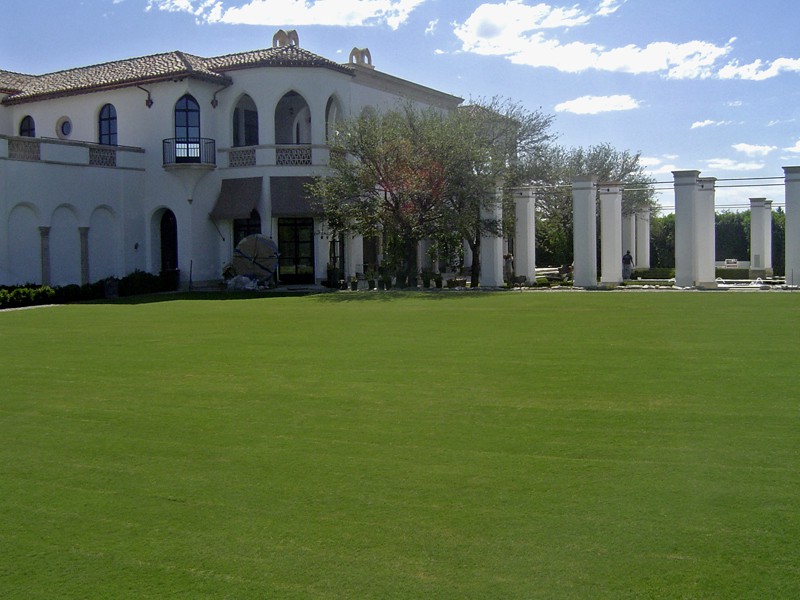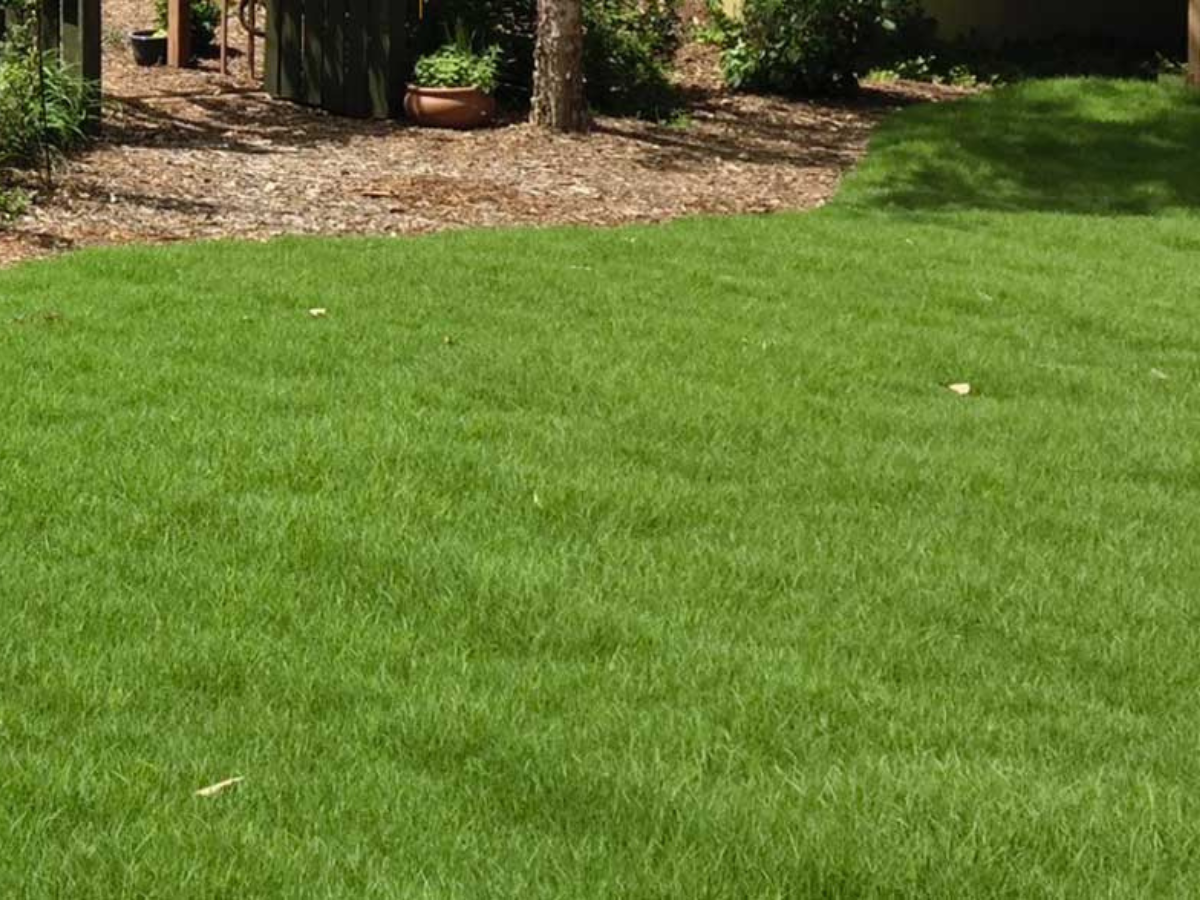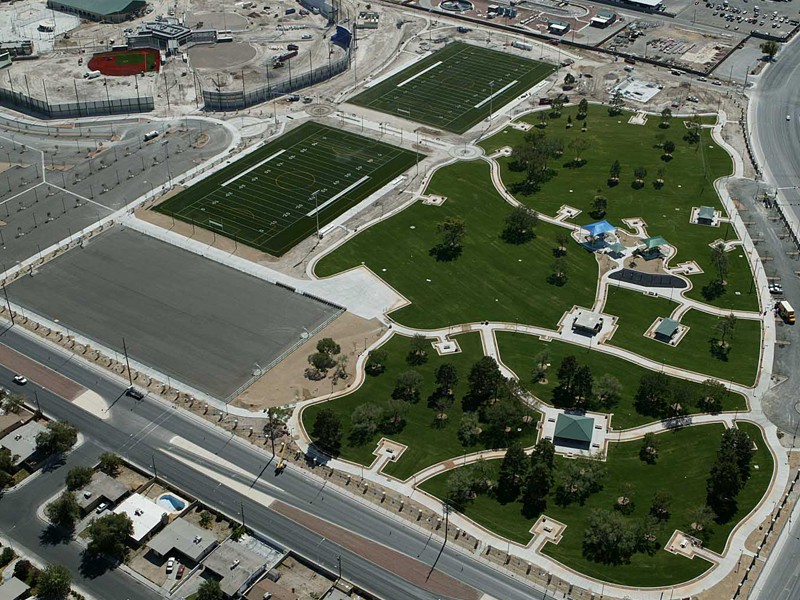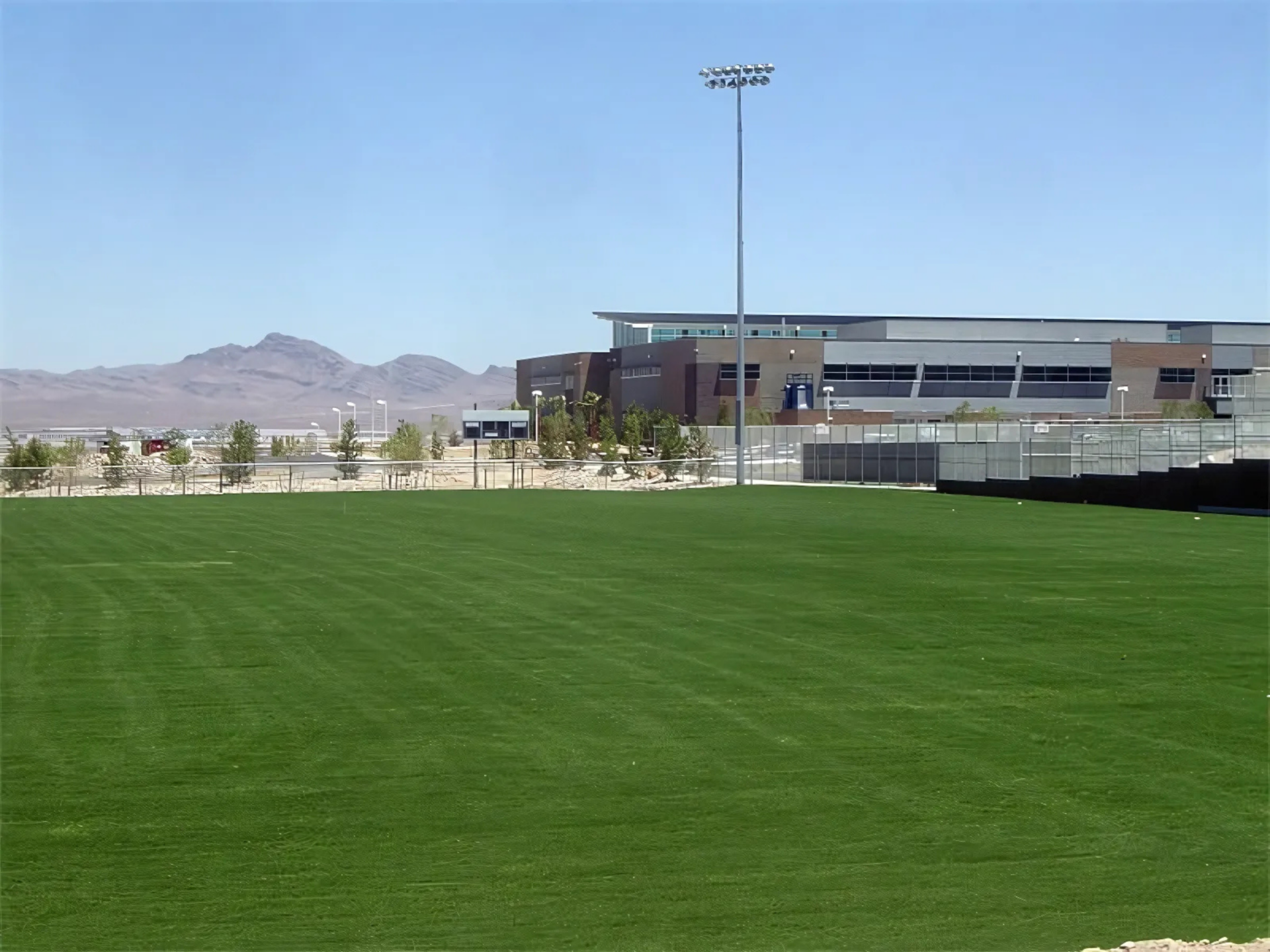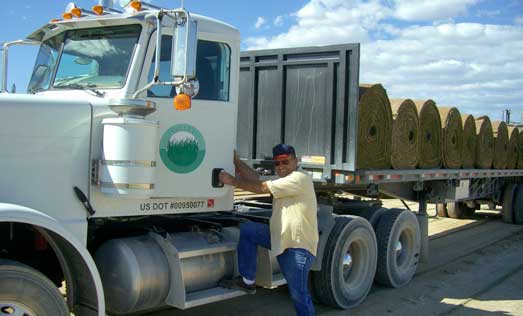Residential Sod
For residential projects, Valley Sod Farms offers high-quality sod varieties perfect for your landscaping project. Whether you choose Trophy Plus, known for its drought tolerance and wear resistance, or the highly resilient Bermuda grass, Valley Sod ensures your grass will thrive in Southern Nevada’s environment.
Valley Sod is committed to providing beautiful, durable sod that elevates the look and health of your home’s landscape.
Residential Sod Varieties
Trophy Plus – Turf Blend
Trophy Plus sod is ideal for residential lawns, parks, and high-traffic areas like play spaces. This tall fescue blend offers:
- Resilience in sun and partial shade
- Durability for foot traffic, making it perfect for families and pets
- Low water needs due to deep roots
- Drought tolerance once established
With minimal fertilization and regular mowing, Trophy Plus remains lush and green with minimal maintenance. This makes it a strong option for those seeking a balance of beauty and practicality in their lawn.
Why does Trophy Plus perform so well in high traffic areas?
Trophy Plus is designed for durability with a dense blend of dwarf turf-type tall fescues that provide excellent wear tolerance. It’s ideal for backyards, playgrounds, and commercial spaces, with deep roots that improve drought resistance and help the sod recover from heavy use.
Is Trophy Plus resistant to pests and diseases?
Yes, with over 80% endophyte levels, Trophy Plus offers excellent resistance to pests such as white grub worms, sod webworms, and chinch bugs. It’s also highly resistant to brown patch disease, ensuring a healthy lawn with improved stress tolerance and better summer survival.
How does Trophy Plus perform in tough environmental conditions?
Trophy Plus thrives in less-than-ideal conditions, including high pH soils. It maintains its dark green color and dense growth, even in challenging environments like Southern Nevada, thanks to certified seed blends and rhizomatous qualities for filling in bare spots.
TIFTUF – Certified Bermuda Grass
*Newest and Most Drought Tolerant Sod!*

TifTuf™ is ideal for lawns, sports fields, and golf courses, delivering outstanding performance in various applications.
This advanced bermuda grass, developed by the University of Georgia, offers exceptional drought tolerance, requiring 38% less water than traditional varieties.
TifTuf™ maintains its lush green color even under drought stress, ensuring a vibrant appearance year-round.
Its quick establishment, fine texture, and durability make it perfect for high-traffic areas, making it the most resiliant sod variety, while its environmental benefits support sustainable landscaping practices.
How does TifTuf™ perform in different seasons?
TifTuf™ demonstrates faster spring green-up compared to Tifway and other varieties and retains exceptional density during summer and fall. It also has better cold tolerance, ensuring strong performance even in cooler climates.
How does TifTuf™ compare to other bermuda grasses in terms of establishment and dormancy?
TifTuf™ establishes more rapidly and takes longer to go dormant, recovering faster when spring arrives. This resilience makes it a reliable choice for consistent lawn quality throughout the year.
What are the main benefits of TifTuf™?
TifTuf™ offers unbeatable drought tolerance, using 38% less water than Tifway and outperforming other tested varieties like Celebration™ and Latitude 36™. It establishes quickly, provides superior wear tolerance, and retains excellent fall color, making it ideal for lawns and high-traffic areas.
Tifway 419
Tifway 419 is a popular bermuda grass variety primarily used for sports fields, golf courses, and high-traffic areas due to its excellent wear tolerance and dense growth.
It thrives in warm climates and is known for its fine texture and deep green color. Tifway 419 also offers good drought tolerance, making it suitable for regions with limited water resources.
Regular maintenance, such as mowing and fertilization, helps maintain its quality. It performs best in full sun and well-drained soils, providing a resilient and attractive turf.
How does Tifway 419 perform in the Vegas Summer heat?
Tifway 419 thrives in heat and is highly tolerant of warm temperatures. Its hybrid bermudagrass composition ensures it remains lush and resilient even under intense sun, making it perfect for regions with hot summers.
What are the maintenance requirements for Tifway 419?
Tifway 419 requires regular mowing, fertilization, and watering (about 1-2 inches per week during active growing season) to maintain its fine texture and dense growth. It performs best in full sun and well-drained soils, ensuring optimal performance in high-use areas.
How do you maintain Tifway 419 bermuda grass during drought conditions?
Tifway 419 has moderate drought tolerance, but during dry conditions, it’s important to water deeply and less frequently to encourage strong root growth. Reduce mowing height slightly to conserve moisture, as this can stress the grass. Regular aeration also helps improve water absorption. Though Tifway 419 can handle some drought, consistent care will keep it resilient during dry spells.
Tifway II
Tifway II is a hybrid bermuda grass known for its density, which surpasses Tifway 419, making it even more resilient to wear and tear.
This fine-textured grass performs exceptionally well in hot climates and high-traffic areas like golf courses and sports fields.
Its superior drought tolerance and disease resistance, along with its rich dark green color, make it a durable and attractive choice for professionals looking for high-quality turf.
Why is Tifway II ideal for sports fields?
Tifway II is perfect for sports activities because of its superior density, which outperforms Tifway 419 in withstanding heavy foot traffic. Its dark green color and fine texture make it ideal for sports fields, while its heat tolerance ensures it thrives in hot climates. Tifway II also recovers quickly from wear, breaks dormancy faster, and stays greener for longer, keeping sports fields in top notch throughout the playing season.
Is Tifway II shade tolerant?
No, Tifway II is not particularly shade-tolerant. Like most bermudagrass varieties, it thrives best in full sun and requires plenty of direct sunlight to maintain its dense growth and rich green color.
How often should I mow Tifway II?
Tifway II should be mowed as often as needed after rooting to maintain a height of 1/2″ – 1″ depending on individual preference and application.
Tifgreen 328
Tifgreen 328 is a versatile hybrid bermuda grass designed for golf courses and athletic fields.
Known for its fine texture and rich green color, it thrives in full sun and offers excellent wear tolerance, making it ideal for high-traffic areas.
Tifgreen 328 features rapid recovery from damage and a strong resistance to diseases, ensuring a healthy, vibrant appearance year-round. Its ability to maintain quality under various conditions makes it a reliable choice for both recreational and professional applications.
What makes Tifgreen 328 Ideal for Golf Courses?
Tifgreen 328 is perfect for golf courses due to its fine texture, vibrant green color, and excellent wear tolerance. It recovers quickly from damage, ensuring that greens remain in top condition even with heavy foot traffic. Its ability to thrive in full sun further enhances its suitability for high-performance golf settings.
What are the recommended Applications for Tifgreen 328?
Golf course greens, tees, commercial and residential applications.
What are there any mowing requirements for Tifgreen 328?
Tifgreen 328 should be mowed as often as needed to maintain an acceptable height for the application with a reel mower or the lowest setting on a rotary mower. It should be mowed at a height between 1/4″ or 3/4″ depending on individual preference.
How to Measure for Sod
How to Measure for Sod
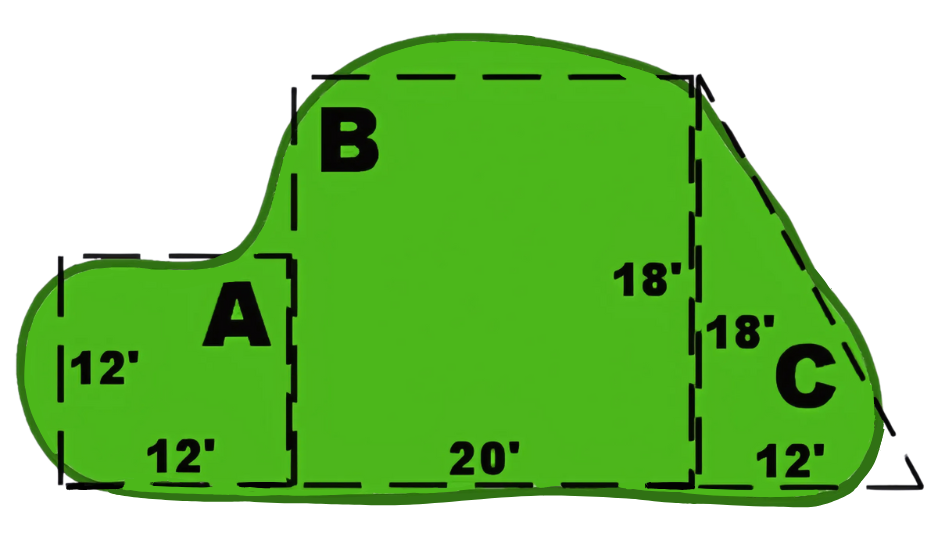
Here’s the simple way to measure the area for the amount of sod you’ll need:
1. Start by dividing the area to be sodded into squares, rectangles, and triangles, (as in the diagram above).
- Area A is a square, with 12-foot sides.
- Area B is a rectangle, with 18×20-foot dimensions.
- Area C is a triangle, with 12- and 18-foot sides forming a right angle. (Remember: a right angle is 90 degrees!)
2. Figure the area of each shape.
- Area A is 144 square feet, (12 times 12).
- Area B is 360 square feet, (18 times 20).
- Area C is 108 square feet, (18 times 12, divided by 2).
3. Add the square footage of all areas to get 612 square feet, (144 + 360 + 108).
HINT: Add five to 10 percent to account for odd shaped areas and patch work around trees, bushes and other items in the area to be sodded. In the example above, you’d add about 60 square feet to your order!
Turf Tips
Summer Patch
May begin as small circular light brown patches that progress to larger patches. Weeds will typically begin growing in the dead patches. The color fades to yellow as the turf dies.
When turf with a summer patch is dug up, the roots are dark brown, hard, and dry-rotted in contrast to the white color of healthy crowns and roots. Summer patch is so named because it will occur during extended hot weather and especially where there is poor drainage. Sound familiar?
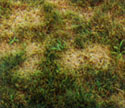
Pet Urine
If pet urine is causing constant trouble in your lawn, consider Micro Clover as an alternative. This variety is immune to pet urine, making it a great solution for pet owners. In addition to being resilient against urine, Micro Clover is pet-safe, can handle moderate foot traffic, and stays green throughout the year. It’s a durable, low-maintenance option for anyone looking for a beautiful lawn that stands up to the challenges of pet ownership.
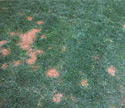
Dollar Spot
Prone to attack lawns during the hot dry season. The size of the damaged areas of grass will typically be about the size of a silver dollar.
The blades of grass will have pale beige lesions with red-brown borders. A faint cobweb-type growth may be seen on the leaves. This is often more common when mowing is too frequent.
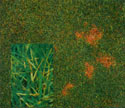
Turf Disease Problems
Summer can be brutal on plants here in the desert, and there are a number of challenges we can have with our lawns.
If there are signs of pests or disease you’ll need to know what you’re up against and deal with it. Yellowing patches will be one sign, but may only indicate a watering issue. Lawn fungus is common here and has many faces, so let’s look at that issue.
Brown Patch
The leaves of the grass will have tan edges, and the patch size will be about 6 to 20 inches in diameter. Excessive nitrogen levels in the soil will contribute to the development of this disease as will night time watering. Proper cultural practices will generally prevent this from getting started in your lawn.
Mowing
Before you mow again, please have the mower blades sharpened and make sure they are adjusted properly. Set the mower high so that you don’t cut more than 1/3 of the leaf blade at a time. Sure, you’ll be cutting a little more often, but grass can become stressed when too much is cut off at one time.
Cut about a third of the height each time. Cutting a lawn too short might look nice at the time, but then it requires more watering and feeding which requires more mowing- and so we go.
Thatching
Fall is a good time to remove thatch buildup. If the thatch is 1/2 inch deep or more, it’s time to remove it. For a small lawn, a thatch rake might be the most convenient tool for removing it, but if you have a larger lawn you’ll likely want to get a de-thatching blade to put on your mower, or rent a dethatcher.
Pythium Blight
With this disease the spots turn from greasy to slimy before the grass dies out. This is the fungal disease that is easily spread by contaminated mowing equipment.
Control: Prevention is the Best Care
- Night watering is probably the most frequent cause of fungal disease on your lawn. Watering grass at night, when it releases oxygen and absorbs CO2, significantly increases the risk of disease.
- Grass clippings left on the lawn will harbor the growth of fungus and restrict oxygen reducing plant health.
- Over fertilization is another no-no. Moderation in all things is the old saying and it certainly applies here.
- Avoid cutting your lawn too short. This produces stress and the weakened turf will be more subject to disease.
- Do not fertilize your lawn if you think it may be infected- treat first! Chemical treatment is available for most types of grass fungus. You’ll find fungicide in nurseries in the chemical aisle. Follow the instructions on the label for the best results and safe application.
Sod Installation Tips
Sod Installation Tips
FOLLOW THESE GUIDELINES TO INSURE A HEALTHY AND BEAUTIFUL LAWN:
1. Rake out rocks larger than 3/4″ from soil. The soil should be loose but firm. It is recommended to add organic matter to your soil like a soil conditioner, fine mulch, or peat moss. Organic matter helps to keep the soil loose and helps retain moisture. Work this into the soil approximately 2″ to 4″ deep using a tiller or landscape rake.
2. Test the sprinkler system to make sure you have good head-to-head coverage. Check for blocked sprinkler heads, broken pipes, etc. Make all adjustments before and after laying sod.
3. Rake 16-20-0 or 15-15-15 fertilizer into the top inch of soil. This helps the sod root faster. Follow the directions on the bag for application rates.
4. Wet down the areas to be sodded and keep moist until the sod is laid. This will help to even out the top of the soil and remove air pockets. In summer, a dry base can cause sod to dehydrate, burn root hairs, and stress its system.
5. INSTALL SOD IMMEDIATELY UPON DELIVERY. IT IS A LIVING THING AND NEEDS WATER AND GROUND CONTACT TO SURVIVE.
6. Begin installing sod along the longest straight edge of your lawn. Push edges tightly against each other. Stagger joints in each row in a brick pattern. Avoid gaps or overlapping. On slopes, place sod across the slope. Sod can be easily cut to conform to curved boundaries, trees, etc., with a sharp knife. As you lay down a section of sod, water it with a hose. Keep sod moist at all times.
7. In hot weather, protect any unlaid sod by placing stacks in the shade or covering them with an old sheet and wetting it down with water. Water sod within 30 minutes of installation.
8. Avoid causing indentations or air pockets after laying sod. You should keep good sod-to-soil contact. Rolling the area after sod installation will help to do this, but is not required.
9. Remember, the roots of your new sod exist within the top 1/2″ – 3/4″ of soil. Until the roots are established, they will depend entirely on this thin layer for survival.
NOTE: You are exempt from the watering schedule published by the Las Vegas Water District for 30 days after new sod installation.
10. Weather conditions can greatly affect sod. Be sure your sod has enough moisture to survive hot, windy and dry conditions. Adjust the watering schedule according to these conditions.
11. Hand water areas near buildings and curbing where reflected heat could dry out turf.
12. During the first 2 weeks of installation, avoid heavy or concentrated use of your new lawn. This gives the roots an opportunity to firmly knit with the soil and ensures that the turf will remain smooth.
13. Mow as often as needed to remove 1/3rd of the leaf blade. Keep the lawn longer in the summer to reduce heat stress. Keep mower blades sharp.
14. For Fescue, fertilize your yard as needed to keep a rich green color. The lawn should be fertilized every 45 days in the spring and fall. Lesser amounts can be applied in the summer months but use caution. A high nitrogen fertilizer in the late fall ensures a good green color throughout winter.
Residential Sod FAQ
How do I know I am receiving a turf that is suitable for my area?
Valley Sod uses the latest varieties of certified blue tag seed to ensure the best quality turf. All varieties are tested to determine if they are adaptable to growing in our high desert conditions. The location of Valley Sod’s growing grounds is just 45 minutes southwest of Las Vegas. This close proximity guarantees that sod is always freshly cut and grown in similar conditions to the Las Vegas valley.
How do I decide between a cool season grass like fescue or Bermuda, a warm season grass?
Nevada is classified as a Transition Zone because of its mild seasonal climate. Cool season grasses grow faster in the spring and fall and slow down in the summer/winter. Most people prefer the look of a green yard all year round without having to overseed. Fescue will stay green during the winter if properly fertilized before late fall. Bermuda goes dormant in the winter and requires an overseeding of rye grass to keep the yard green.
Why did the sod edges dry out after installation? Will it recover?
More than likely your sod will recover from dry edges. Sod needs to be installed so the edges are butted close together. Gaps will cause edges to dry out. Try to push sod pieces together to avoid gapping. Sod edges can dry out while sitting on the delivery pallet if not installed promptly. Weather and wind can also contribute to drying edges. Conscientious watering, time and patience should result in the regrowth of the damaged area.
What about fertilizing new turf?
It is recommended to use a starter fertilizer such as 16-16-16, 15-15-15, or 16-20-0 at the time of installation. Follow the directions on the bag for application rates. Use half the recommended amount on the soil before installation and the other half sprinkled on top of the grass after installation.
What fertilizer should I use depending on the time of year?
| January, February | High nitrogen winter formula |
| March, April, May | 15-15-15 or a balanced fertilizer or 16-6-8 w/ iron |
June, July, August | 16-6-8 or a formula that has slow-release nitrogen and potassium |
September, October | 15-15-15 or balanced fertilizer |
November, December | High nitrogen winter formula |
Can I put sod on top of existing grass that did not take or has died?
No, Fresh cut sod needs soil-to-soil contact. In other words, the existing sod or dead grass must be removed first. Sod roots must be in contact with soil or they will dry out. Level out soil where the old sod has been removed, add 2″ of top soil to cover the old grass and soil amendments as recommended in our installation instructions, dampen the soil, sprinkle 16-20-0 fertilizer and then lay sod on top soil. Make sure there is soil-to-soil contact. Please note that if sod is laid over Bermuda grass it must be killed off entirely or there will be regrowth of the Bermuda in warm weather.
What is the main cause of death of sod?
WATER! Either too little or too much water is the most common mistake that homeowners make when watering their newly installed lawn. Too little water will cause the sod to dry out and stress. Too much water can be worse over time causing roots to rot and sod to die. Watering schedules and times need to be adjusted to the time of year on established turf to keep it healthy.
How soon can the lawn be mowed after installation?
As the grass is growing on top, the roots are growing on the bottom. Gently tug on the sod to see if it has rooted. This normally takes about two weeks. Do not let the grass get too long before mowing. Long grass can block sprinkler heads and create watering problems. Keep grass blades slightly longer in summer to shade roots.
Should I aerate my yard and when should I do this?
Yes, aerating is beneficial to keep your lawn healthy. Do this during the spring or fall when it is cooler approximately every 3-5 years depending on your lawns’ condition. If your grass gets a lot of traffic you may need to do it more frequently.
Sod Installation Service
Sod Installation Service

We offer sod installation services on jobs of 20,000 square feet or more, depending on availability.
Licensed landscape contractors can be referred to customers for smaller projects. Installations can be made using the pallet load or our big roll installer.
Place an Order and Schedule Your Delivery
Place your order by phone at our Las Vegas office, Mon-Fri, 9:00 AM - 4:00 PM PST
For next-day delivery, orders must be placed by 11:00 AM.
Payments are accepted in person at our sales office or by phone using VISA, MasterCard, American Express, or Discover. All orders must be prepaid before shipment.
Valley Sod Office
3725 W. Teco Avenue, Suite 9
Las Vegas, Nevada 89118

